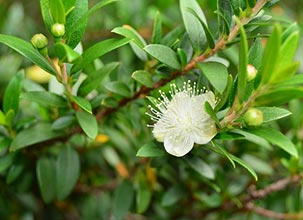What is Myrtle?
Myrtle leaves, branches, and fruits have been used since Biblical times to flavor meat in the Mediterranean islands of Sardinia, Corsica, and Crete and western Asia. The dried berries were used as a substitute for black pepper.
Origin and Varieties:
Myrtle is indigenous to Mediterranean regions of northern Africa, southern Europe, and the Middle East. Lemon myrtle: Backhousia citriodora is native to Australia.
Spice Description
Myrtle seeds are purple-black berries that are used whole or coarsely ground. Its leaf is used whole or chopped. Myrtle berries are sweet, with juniper and rosemary-like flavors. The leaves have spicy, astringent, and bitter taste with a refreshing, fragrant, and orangelike aroma. Lemon myrtle has a refreshing aroma and taste.
Chemical Component
Leaves have 0.2% to 0.8% essential oil, with myrtenol, myrtenol acetate, α-pinene, limonene, linalool, camphene, cineol, geraniol, and nerol. Lemon myrtle leaf has 4% to 5% oil, mostly terpenoid aldehydes, citral (90%), neral, and geranial.
Cooking with Myrtle
In the Mediterranean, the berries were initially used to flavor wine but are now more commonly used in desserts, liqueurs, and sweet dishes. The leaves are used in stews, roast meats, stuffings, salads, and meat ragouts. The leaves are used to wrap wild game or roast pork before cooking.
Italians, especially Sardinians, use myrtle branches in the same way allspice branches are used in the Caribbean. They wrap meat, other game meats, birds, and poultry with myrtle branches and then roast, broil, or smoke them. The leaves are also stuffed in the meats and are removed before serving. T
he burning myrtle wood and leaves provide a fragrant note to the meat. Australians add it to roast poultry, seafood, salad dressings, many sauces, and curries, and infuse it in vinegar. Spice Blends: smoked meat blends, roast blends, and meat ragout blend.
Health Benefits of Myrtle
The berries are used as an antiseptic for bruises, and the leaves are used to relieve gingivitis and sinusitis.
Other Names
myrtle pepper: Corsican pepper, allspice. It is also called adus (Amharic), hadass, raihan (Arabic), mrdeni (Armenian), bilati mehendi (Bengali), heung tu much (Cantonese), myrte (Danish), mirte (Dutch), moord (Farsi), mirtia (Greek), hadas (Hebrew), vilayati mehndi (Hindi, Punjabi), mirto (Italian), myrtti (Finish), myrte (French, German), jinbaika (Japanese), tao jian niang (Mandarin), murta mirto (Portuguese, Brazilian), myrt (Russian), arraya’n/mirto (Spanish), myrten (Swedish), kulinaval (Tamil), mersin (Turkish), and habulas (Urdu).
Scientific Name
Myrtus communis Family: Myrtaceae (myrtle family).
Image by WhiskerFlowers from Pixabay

